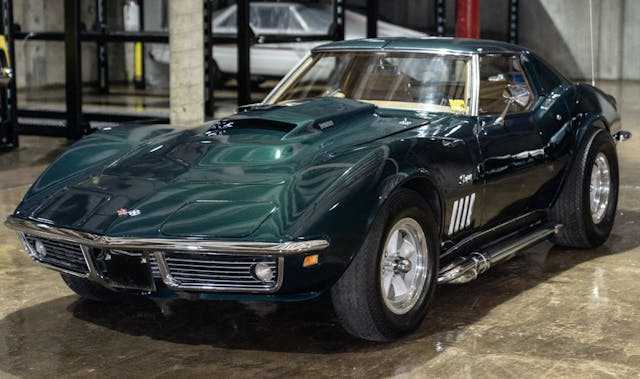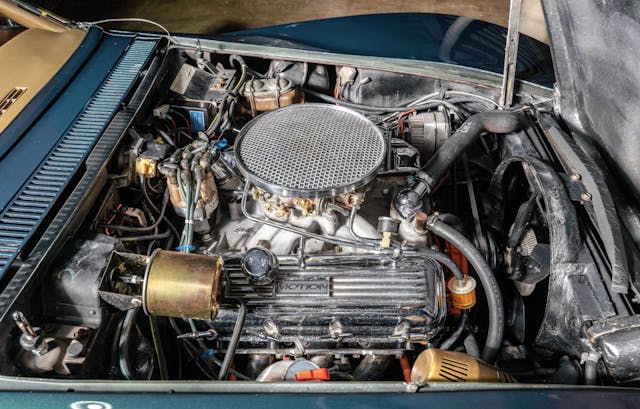Motion’s Phase III Corvette was a 600-hp street/strip Stingray you could buy from a dealership
Today we’re familiar with Callaway, Roush, and Shelby. In the ’60s we had Royal Pontiac, Motion Performance, and Shelby. Just like today, those midcentury tuning houses would take a factory vehicle, tweak the suspension, bolt on new wheels and tires, and perform a little magic under the hood. A beautiful Motion Phase III 1969 Corvette up for sale on Bring a Trailer reminds us that some tuners went a lot further than others.

Motion Performance teamed up with Baldwin Chevrolet on Long Island to sell some of the meanest muscle cars of the ’60s. They also took on Corvette projects for those that wanted sporty style and handling to go with the native, brutal power. While some Baldwin-Motion Corvettes featured reworked body panels and ditched the pop-up headlights, this one is practically subtle, forgoing most of the wild cosmetic upgrades and instead focusing on serious performance.

This Phase III car is powered by perhaps the only ZL/X big-block still known to exist. The monster engine displaces 482 cubic inches. Our best guess? That’s due to a 4.25-inch stroker crank and a massive .125-inch overbore to net a matching 4.25-inch bore. The engine breathes through a set of side-exit headers and is topped with aluminum heads and an aluminum Edelbrock TM2R single-plane intake and a Holley 850-cfm four-barrel with a fly-eye air cleaner. That Edelbrock Tarantula intake, with its twisted carb-mounting surface, is definitely outdated and the single-plane design surely kills a lot of low-end torque. On the other hand, with 5.13:1 gears in the Vette’s rear end and 7.9 liters of big-block, those Mickey Thompson Indy tires probably had more torque than they’d bargained for, so perhaps a single-plane is the way to go.

The rest of the drivetrain consists of a Muncie four-speed with Hurst shifter and a Hone 30 percent overdrive. That “Hone-O-Drive” was the secret to making the Motion Stage III Corvette a dual-purpose animal, one capable of 11-second drag-strip runs and high-speed highway cruising. Pulling the lever on the passenger side of the transmission tunnel engaged the overdrive, essentially taming that 5.13:1 rear-end gear to act like a 3.59:1, which would land smack dab in the middle of the six factory-available rear axle ratios in 1969 and let the big-block cruise at an easy pace.

We’ve spent all this time talking about the mechanical aspects of the car without reveling in the car’s gorgeous lines and color palette. The body is finished in its original Fathom Green and the interior is saddle tan. If there’s a more elegant color combo for a Stingray, we haven’t seen it. Of course, some of the car’s speed parts are nicely visible from the outside, namely the polished exhaust, whose primary tubes are plainly visible below the Stingray’s gill slats. The Motion Stage III treatment also added a unique hood, which may have been necessary due to the Edelbrock intake. The hood uses locking pins at the rear and a raised center section reminiscent of the 1967 Sting Ray’s big-block hood. Other Stage III modifications include a Line/Loc for warming up the tires, a GT fuel filler cap in the rear deck, and American Racing T70 wheels.

This car has previously sold in 2019, 2016, and 2013, when we last got a close look at it. Our report from that 2013 sale, when it went for $136,000, noted the car’s remarkably low 15,000-mile odometer. The bodywork seemed to be in decent shape in general, save for a few slight waves in the doors and a small crack in the rear deck. The car appears to have very few miles in the last eight years, because the current odometer reading is still in the 15,000-range.

While Baldwin-Motion doesn’t have the cachet of Shelby, for Chevy fans looking for one of the most outrageous dual-purpose sports cars the big-block era had to offer, this may be the pinnacle of tuner Stingrays.


